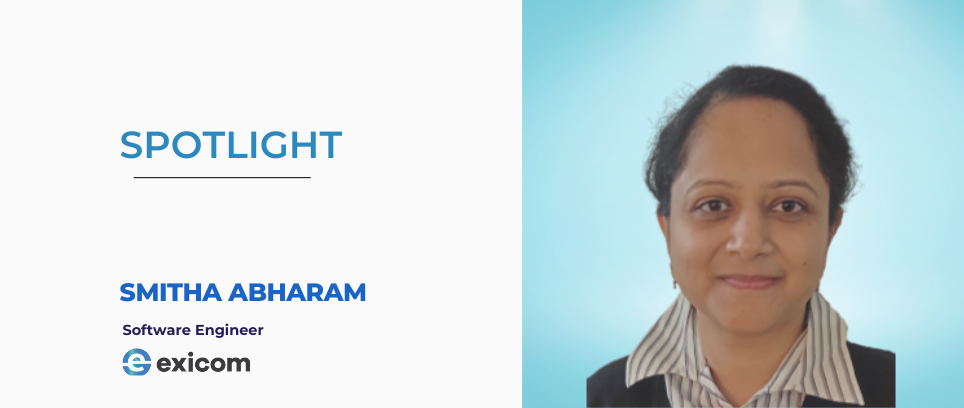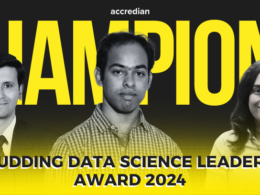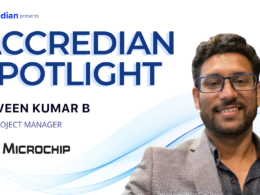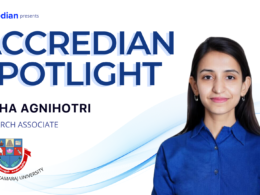In this Accredian Spotlight interview, we feature Smitha Abharam, a Data Science enthusiast making her way into the field of Data Science.
Question 1: Which program and batch are you part of at Accredian? Tell us more about your current work profile.
Smitha: Hi everyone. I am part of the PGP Data Science & AI Program, November 2021 Batch. I’m currently on a career break and working towards switching into the domain of Data Science & AI.
Question 2: Walk us through your career journey and what got you interested in Data Science and Machine Learning.
Smitha: After completing my B.Tech in Electronics and Communication Engineering in 2009, I joined as an Engineer Trainee with Continental Device India Ltd. Following this, I had been working with Exicom Telesystems Ltd. till 2021 as a Software Engineer in the R&D Department. Currently, I’m on a career break and working towards transitioning into the field of data science and AI.
During my journey, I developed a keen interest in analysis, evaluation, and data cleaning. I seized the chance to enroll in this Accredian course, which has helped me better understand the fundamentals of Data Science and other related fields like machine learning, artificial intelligence, deep learning, natural language processing, computer vision, and many others.
While undergoing this course, I have realized the pain and efforts taken by the Data Scientists and all related departments in performing their respective roles and bringing to the table the real-time outcomes which has been helping layman and businesses around the world.
Question 3: What Data Science and Machine Learning Tools and packages have you mastered so far in your Data Science and AI program at Accredian?
Smitha: During my journey, I have been working with tools like Jupiter, Google Collab, Matplotlib, Scikit learn, Visual Studio, and Tableau, and packages like Pandas, NumPy, and Seaborn.
Question 4: What are some of the initial challenges you faced when you got started on your Data Science journey, and how did you overcome them?
Smitha: Because I had no development experience, the first challenges I faced were understanding how statistics were used in this field of data science, the basic workings of all the algorithms, how to code in Python and R to extract the necessary information from datasets, and many others. But with the help of the instructors and the lectures that followed, I have managed to overcome it by continuously working on my knowledge.
Question 5: Who is your favorite faculty member at Accredian and what did you learn from him the most?
Smitha: I got to learn many different things from all the instructors at Accredian who have diligently put their efforts into training us and also preparing us for our career transitions.
Question 6: What is the goal of Data Science?
Smitha: From the beginning, the basic goal of data science was to make our lives more comfortable and predictable. It helps us take decisions for the current situation at hand and predict the future based on what has happened in the past and many other factors that are crucial for decision-making.
Question 7: How has Data Science evolved in the last few years?
The term “data science” has evolved over the years from using statistics for problem-solving to including topics like Machine Learning, AI, the Internet of Things, analyzing enormous volumes of data on the cloud, and many more to come.
With the flood of new information coming in and businesses seeking new ways to increase profit and make better decisions, Data science started to expand to other fields, including medicine, engineering, and more.
The proliferation of programming languages like Python and procedures to collect, analyze, and interpret data paves the way for data science to become a popular field. It is today.
Question 8: What are the current trends in Data Science that you are most excited about?
Smitha: The current trends in data science are as follows:
Firstly, the data-driven consumer experience, such as the provision of user-friendly services, like AI chatbots and Amazon’s cashless convenience stores, has helped improve sales in almost all types of industry sectors.
Secondly, smart homes, smart factories, and smart cities can now be created by leveraging AI, enabling IoT devices to act without human intervention, and using superfast networks such as 5G.
Thirdly, AI and databases rely on Cloud Computing for accessing large volumes of data in one place. Lastly, data visualization tools help analyze and make decisions on a massive amount of data.
Question 9: Which are some of the blogs that you follow?
Smitha: I follow sites like Towards Data Science, AnalyticsVindhya, Stack Overflow, Statquest, and various YouTube channels on data science.
Question 10: What is your advice to anyone wanting to start a career in Data Science?
Smitha: My advice to anyone interested in pursuing a career in data science is to practice statistics concepts and research how they are applied in the analysis. You need to learn programming languages like Python, R, and SQL, and visualization tools like Tableau, Kulich View, and Power BI.
We hope you enjoyed reading this interview. Check out the Accredian Spotlightfor more interesting student stories like this.






